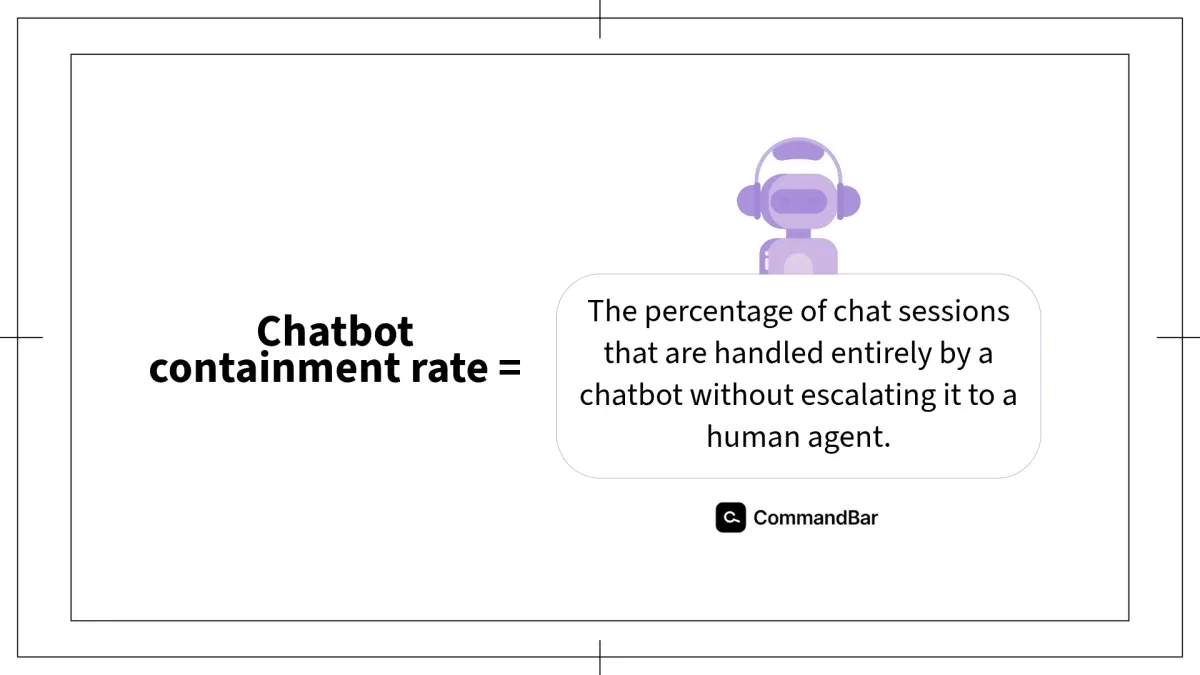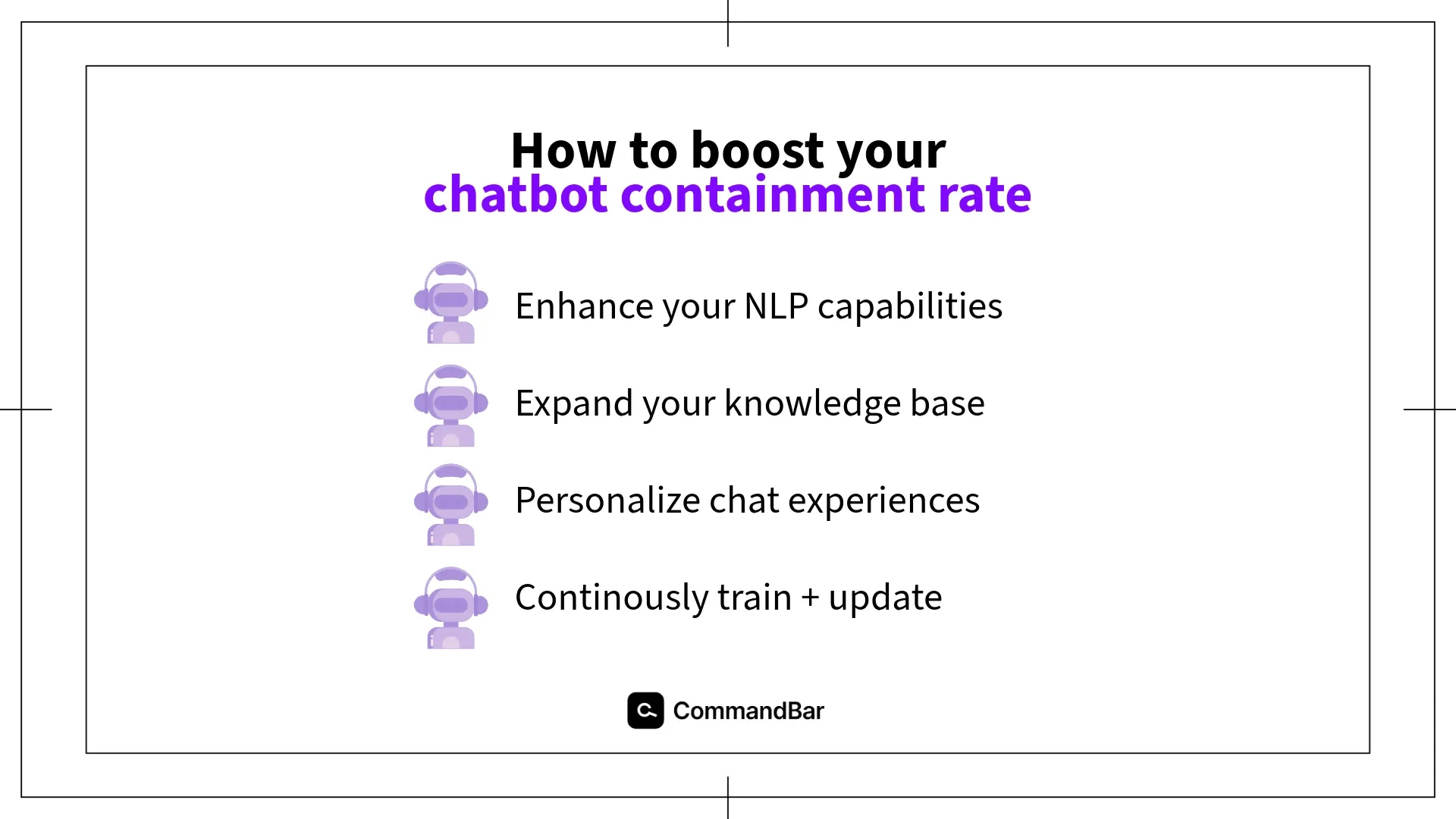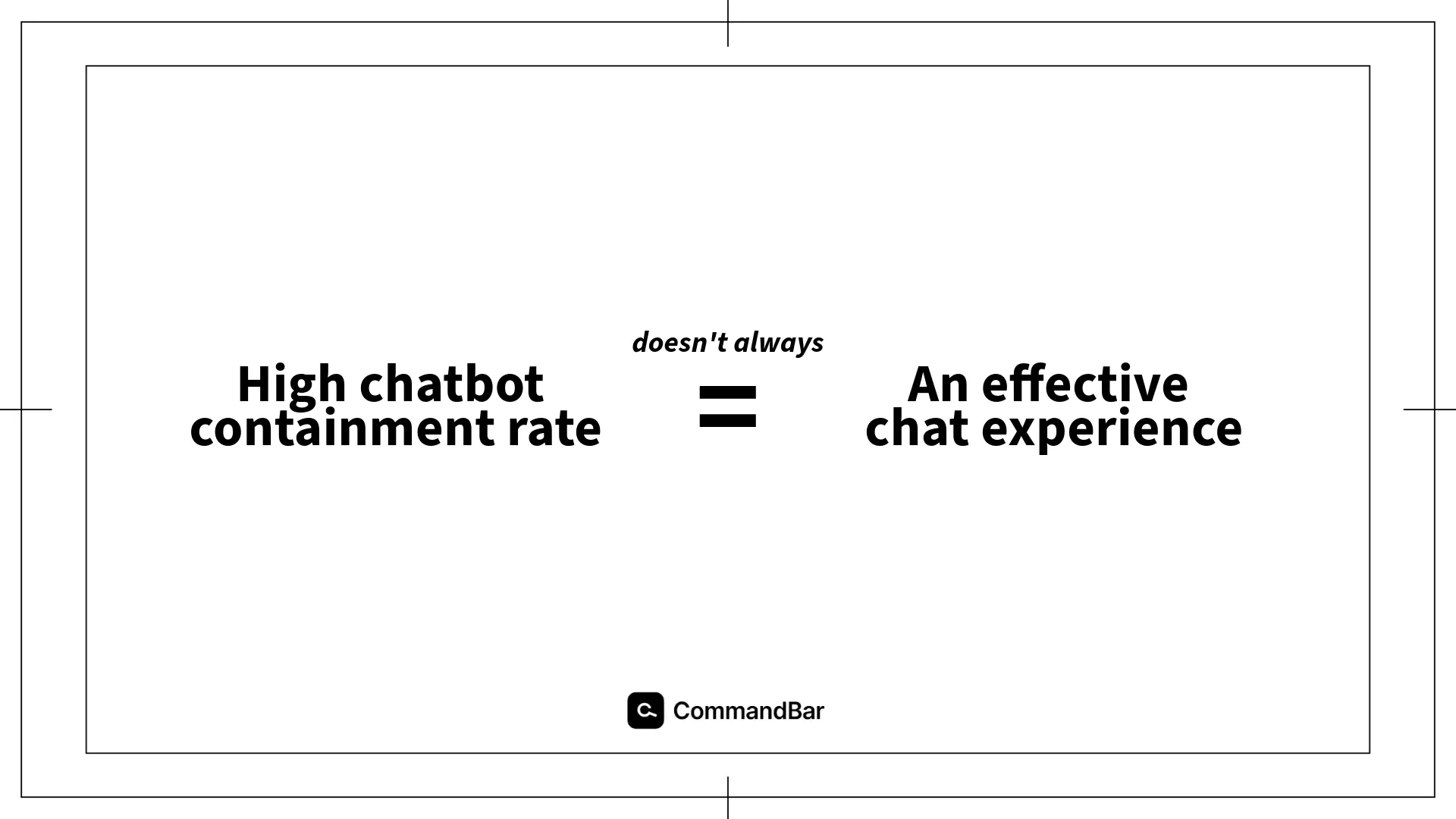Chatbots have quickly become a normal and even desired part of the software experience. A few years ago, users overall had a strong aversion towards them, but now that’s changed. Now, more than 90% of consumers think that businesses should use chatbots.
And yet, only 30% of consumers find the responses they receive to be very effective at resolving their issues. 58% thought that they were “somewhat effective.”
So, there’s a clear craving for chatbots, both on the business and consumer side, but there’s also a clear need for improvement.
The trick is to create better chatbots that provide genuinely helpful support to your users while saving your support team time. But if you’ve played around with implementing chatbots, you know that’s often easier said than done. It takes a lot of intention and strategy to make sure that you’re not sacrificing your user experience for the sake of saving some time.
That’s where chatbot containment rate often enters the picture. It’s one of the most important metrics to give you a temperature check on the impact your chatbots are having.

What is chatbot containment rate?
Your chatbot containment rate refers to the percentage of chat sessions that are handled entirely by a chatbot without escalating it to a human agent.
Typically, a higher containment rate indicates a more effective chatbot, because it shows that your users are getting their questions answered or concerns addressed sufficiently by the bot.
So, a 100% containment rate means that zero users needed more help after talking to a chatbot, while 0% means that every user needed additional help. The average chatbot containment rate that SaaS companies shoot for is 80%, but this can often vary depending on the complexity of your product or service. Highly complex products that require more nuanced support, for example, are likely to have a lower containment rate.
The reason that teams get so focused on boosting this rate is that it helps them prove the ROI of their investments in chatbots. It can reduce support costs, lead to better efficiency, and hopefully boost the overall customer experience or satisfaction.
Factors that can boost your containment rate
If your chatbot containment rate isn’t quite where you want it to be, there are several different levers you can pull to boost it by providing a better chat experience for your users.

Enhanced NLP capabilities
A lot of the quality of the chatbot experience will lean on the technical components on the back end of your chatbot. So you want to make sure that you’re using the most powerful NLP model for your needs.
Depending on the model that you choose, your bot will have varying capabilities to truly understand any nuances in communication, including different languages and slang. This is the crux of a good chatbot.
Your goal should be to get as close as possible to making the chat experience feel like one human talking to another. You want to let your users talk to your bot in their own language and receive responses that sound like an actual human.
Expanded knowledge base
No matter how great of a model you use to build your chatbot, its ability to understand questions about your specific product are only as strong as the knowledge you feed it.
You want to make sure to give your models access to any potential topics your users may ask about, including FAQs, definitions, and how-tos. This can include support assets that are available in your support library and in internal documentation.
It’s extremely important to regularly update this knowledge base with any information on new products, services, or changes in policy so that your bots never run the risk of providing out-of-date information that could negatively impact the user experience.
To double down on the time-saving aspects of your chatbot, it’s often a good idea to integrate systems that allow for real-time updates to the chatbot's responses. Instead of having to manually update content, especially for information that is subject to change often, you want to use automated tools to synchronize the chatbot’s knowledge base with internal databases or wikis and CRM systems.
Personalized experiences
Real-time personalization is one of the best drivers of a positive user experience. In fact, 47% of B2C consumers and 72% of B2B consumers fully expect personalized content every time they receive support.
So if you have a low chatbot containment rate and are not using personalization, this could be at the root of the problem.
At a minimum, you want to incorporate your user’s history to help the chatbot give personalized responses. If it has access to things like previous chats and their preferences, it’s able to provide more relevant responses, faster.
You can also bake in more advanced contextual awareness by using algorithms that helps the chatbot take into account things like the current product(s) they’re using, location, or even their current emotional tone. Just like a human on the other end of the line would be able to pick up on some of these more nuanced things that the user is bringing to the conversation, the chatbot can as well to make the users feel like the bots just “get them.”
Continuous training and updates
Chatbot technology is by no means in its final state. In just the last 2 years, AI and machine learning have grown exponentially, so you want to make sure that your chatbot experience doesn’t stay stagnant.
Many of the companies with the highest chatbot containment rate do this by continuously incorporating implicit feedback through machine learning feedback loops. With this strategy, AI algorithms automatically analyze chat lots to identify areas where the chatbot may be underperforming and course corrects. That means that the more your chatbots are used, the better they get.
Sometimes, you may need explicit feedback, since there are some things that the algorithms may pick up on. That’s why you should just ask. Use short end-of-chat surveys to gauge your users’ satisfaction with their experience. Often, those who had a sub-par experience are the most likely to provide feedback, so this is a great opportunity to hear it from the users themselves what the experience is lacking. This helps you make more targeted improvements.
Is containment rate really the best indicator of success, though?
Containment rate is absolutely an important indicator of how much support you’re able to automate away, but it’s not necessarily a definitive measure of how effectively you’re solving your users’ problems or how positive of an experience you’re providing to your users.

One of the limitations of chatbot containment rate is that it doesn’t automatically mean that your users were able to reach their goal. For example:
- After chatting with a bot and not getting answers, the user could have exited the chat and called the support line.
- The user could have been so frustrated with the bot that they gave up trying to find support.
- Or the user’s internet connection could have dropped.
Because you can’t equate lack of escalation to human support to success, you can’t consider containment rate in a vacuum. In order to get a true measure of how smoothly your users are able to user your chatbot to receive support, you need to integrate your other customer experience metrics into the equation.
For example, if you’re seeing high containment rates but also high churn, you may need to dig into moments where the frustration with chat bots may be the final push to cancel. Or on the flip side, perhaps you’re seeing very low containment rates for questions about a specific feature or product, but engagement with that product or feature is at an all-time high. Perhaps the low score is not an indicator of a poor chatbot, but rather an indicator of more users wanting to dig deeper into the capabilities.
Taken as a whole, you can make well-rounded decisions on creating the best, most helpful, and most ROI-boosting decisions with your chatbot strategy.

















